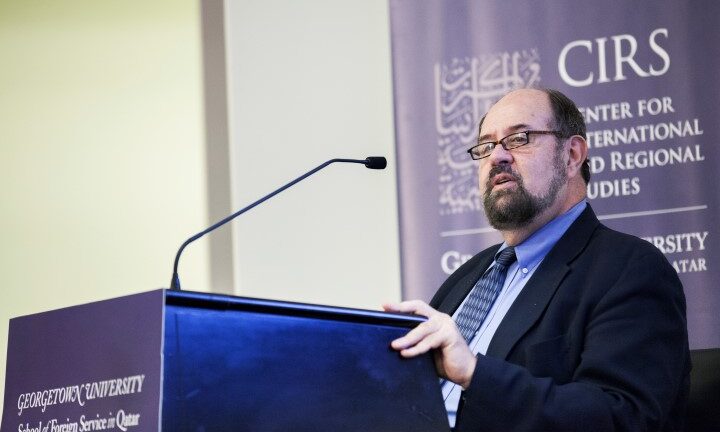Dialogue Series, Regional Studies
William Beeman Lectures on Iranian-Arabian Biculturalism

William O. Beeman, Professor and Chair of the Department of Anthropology at the University of Minnesota and President of the Middle East Section of the American Anthropological Association, delivered a CIRS Monthly Dialogue on “The Khalijis: Iranian-Arabian Biculturalism in the Gulf Region” on October 22, 2012. As an introduction, Beeman gave the audience some background to what he described as “one of the longest running toponymic battles.” There has been disagreement in the recent historical period over whether the body of water between Iran and the Arabian Peninsula should be called “the Arabian Gulf” or the “Persian Gulf.”
In order to resolve this historical contention, Beeman said that he uses the term “Khalij” to describe the body of water, and “Khaliji” to describe the residents of the region. These are terms commonly used in the discourse of the region and are understood in Arabic, in Persian, and in some South Asian languages as well. “I want to call into question the nature of the identity of the people who live in this region, and rather than identifying them either as Persian or Arab, or calling this body of water the Persian Gulf or the Arabian Gulf, I want to make a case for these individuals as residents of this region, whether they are on the Iranian side or on the Arab side independent of an exclusive Arab or Persian identity,” he said.
Such communities are formed as a result of historical factors, including migration, trade, shifting colonial boundaries, or as the results of intermarriage or cultural borrowings that occur as a matter of course when populations come into contact. “The Khalij is a rich mélange of cultural differences made up of Arabic, Persian, South Asian, East African, Portuguese, French, and English,” among others, Beeman noted.
Linguistically, the people who live in this region have been comfortable communicating in a number of languages, and even forming new ones that are a mix of Arabic, Persian, and Indian languages. A similar example is Swahili – meaning “coastal” in Arabic – and the mutual influence of Arabic and East African languages on each other as a result of contact and trade across the Gulf of Aden. “Many people living on either side of the Khalij are fully bilingual, and frequently tri- and quad-lingual,” Beeman said.
The “geographical impenetrability” that separates the Khalij from the inland regions meant that people on both sides of the water had a closer cultural identity than what they shared with their own inland Arab or Persian communities in terms of cuisine, dress patterns, marriage patterns, religious rituals, and discourse structures. Often, because of the strong marriage and trade ties, families would be dispersed on both sides of the Khalij and, to this day, have strong cross cultural and cross border ties. Before modern air travel, the ease of maritime travel across the Gulf and the difficulty of inland travel across deserts and mountains meant that “people living on the coast of the Khalij found that it was much easier to communicate with each other than it was to communicate with people who lived inland,” Beeman said. Boats could carry much heavier loads much more easily than any form of overland transport, and so the Khalij was an area that thrived both culturally and economically.
In conclusion, Beeman said that, as a result of state and historical processes, there were several events that had a profound effect on changing the unified nature of Khaliji culture, including colonial territorial demarcations and competition. He argued that “the early impositions of state structures in the region, which had been blissfully absent for centuries, caused an overlay of state identity, which has served to obscure the basic commonalities between the members of the population of this region.” Other events also contributed to the separation of the Khaliji communities, including the consolidation of Iran under Reza Shah; the consolidation of Saudi Arabia under Ibn Saud; the departure of the British from the Khalij that left a vacuum to be filled by local ruling families who demarcated their territories accordingly; and, finally, the Iranian revolution of 1978-1979 that changed the shape of the Iranian political and cultural landscapes, and caused a break in the historical alliance between the cross-Gulf communities.
Finally, the gradual encroachment of modern state structures into the region required a newly “imagined” idea of identity that necessarily distinguishes one group or nationality from another. Beeman concluded that the shared culture of “Khaliji” identity belies this imagined separation of nationalities and promotes the idea of a diverse community that is inherently multicultural. “This,” he said, “is an ‘unimagined’ community; a community in fact, but not in name, and not in its social identification.”
William O. Beeman was formerly Professor of Anthropology and Director of Middle East Studies at Brown University. Best known as a Middle East specialist for more than 30 years, he has also worked in Central Asia, the Caucasus, Japan, China and South Asia. He has served as consultant to the United States State Department, the Department of Defense, the United Nations and the United States Congress.
Article by Suzi Mirgani, Manager and Editor for CIRS Publications